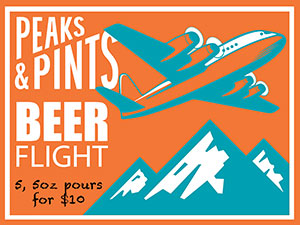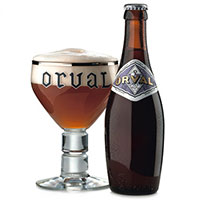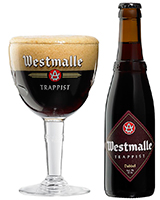 Of the many thousands of beers produced around the world, only 11 can use the name “Trappist.” Six of them are made in Belgium, one in the United States, two in Holland, one in Italy and one in Austria. These beers are all brewed with three criteria in order to earn the name and mark “Trappist”: The beer must be brewed within the walls of a Trappist monastery, either by the monks themselves or under their supervision; The brewery must be of secondary importance within the monastery, and it should witness to the business practices proper to a monastic way of life; The brewery is not intended to be a profit-making venture. Orval is one of the six Belgian Trappist breweries, the only one to make just one beer — and the only one to use the wild yeast brettanomyces in their brewing. Years ago, before U.S. craft beer exploded as it has, Orval was the ambassador of funky beer, often the only wild beer you could find, unless you had a homebrew go awry. By the time Orval bottles reach the Peaks and Pints cooler, they’ve conditioned in the bottle for six months or more, letting the brettanomyces yeast do the fermentation dance with the beer’s residual sugars. Today, Peaks and Pints is pouring Craft Beer Crosscut 9.22.17: A Flight of Trappist, which includes the 2016 and 2017 versions of Orval; exactly a year after the Orval 2016 was bottled. We’ll serve the flight while Orval supplies last.
Of the many thousands of beers produced around the world, only 11 can use the name “Trappist.” Six of them are made in Belgium, one in the United States, two in Holland, one in Italy and one in Austria. These beers are all brewed with three criteria in order to earn the name and mark “Trappist”: The beer must be brewed within the walls of a Trappist monastery, either by the monks themselves or under their supervision; The brewery must be of secondary importance within the monastery, and it should witness to the business practices proper to a monastic way of life; The brewery is not intended to be a profit-making venture. Orval is one of the six Belgian Trappist breweries, the only one to make just one beer — and the only one to use the wild yeast brettanomyces in their brewing. Years ago, before U.S. craft beer exploded as it has, Orval was the ambassador of funky beer, often the only wild beer you could find, unless you had a homebrew go awry. By the time Orval bottles reach the Peaks and Pints cooler, they’ve conditioned in the bottle for six months or more, letting the brettanomyces yeast do the fermentation dance with the beer’s residual sugars. Today, Peaks and Pints is pouring Craft Beer Crosscut 9.22.17: A Flight of Trappist, which includes the 2016 and 2017 versions of Orval; exactly a year after the Orval 2016 was bottled. We’ll serve the flight while Orval supplies last.
 Chimay Premiere (Red)
Chimay Premiere (Red)
7% ABV, 19 IBU
Chimay is made by Trappist monks cloistered away in Scourmont Abbey in Belgium (where they also make tasty Chimay cheese) with the operation’s profits paying for the monks’ pious lifestyle and charitable efforts. Having been around since 1862, Chimay’s a relatively new entry in the world of godly beverages with three commercial beers, including its first beer, Premiere (Red). Its recipe was developed in collaboration between the master brewer, Father Théodore, and Jean De Clerck in the two decades following WWII. Chimay surprisingly prefers American hops, and have used Galena in the past. They now use Cluster hops. Interestingly, they don’t use whole hops but extract because Chimay is designed to lay down and age, the monks prefer extracts, which hold their aroma and bitterness longer than whole hops. Red has a beautiful burnt-sienna color to it, and shows some cloudiness with a pretty decent head. It has a warming stone-fruit sort of smell that is pleasantly gamey. The taste is expectantly sweet, fruity, and malty — a whole lot of flavor without being overwhelming. It’s an accessible example of the classic Belgian ale.
 Brasserie d’Orval Trappist Orval 2016 and 2017
Brasserie d’Orval Trappist Orval 2016 and 2017
6.2% ABV, 36 IBU
When Orval head brewer Jean-Marie Rock retired in 2013, it was his long-term assistant brewer Anne-Françoise Pypaert who replaced him. By doing so, Anne-Françoise became the first female head brewer at a Trappist Abbey. When she started at Orval in 1992 she was one of the first female brewers in Belgium and encountered an industry almost exclusively dominated by men. Joining Orval straight out of university, she has never worked a day anywhere else. The Orval’s brewery produces only one beer to sell, a beer with a high fermentation that continues in the bottle. It’s brewed exclusively from spring water, barley malt, hop cones, candy sugar, and yeast. The tantalizing aroma sings to the nose with candy-sweet overtones and slightly tart notes. Its flavor is pure refreshment with bready, honey-lemon sweetness up front that invigorates the palate and clears the way for the beer’s slightly sour finish. Each bottle is different. The nose displays a tension between hop aromas and fermentation-driven notes that evolve in remarkable ways as bottles age. Dry, tart, and rustic Orval stands out among the typically sweeter Trappist beers. For today’s flight you can taste a vertical of Orval 2016 and 2017.
 Brouwerij der Trappisten van Westmalle Dubbel
Brouwerij der Trappisten van Westmalle Dubbel
7% ABV, 24 IBU
In 1836 the Belgian Westmalle monastery became a Trappist Abbey and began brewing beer shortly thereafter. The holy suds they produced started out as an insider-only deal — a choice beverage to be made and enjoyed by Trappists and Trappists alone, but eventually they decided to expand and opened up a public beer hall in the early 1930s. Westmalle Dubbel is a dark, reddish-brown Trappist beer with a secondary fermentation in the bottle. The creamy head has the fragrance of special malt and leaves an attractive lace pattern in the glass. The flavor is rich and complex, herby and fruity with a fresh-bitter finish. It is a balanced quality beer with a soft feel in the mouth and a long, dry aftertaste.
 Abbaye Notre-Dame de Saint-Remy Trappistes Rochefort 8
Abbaye Notre-Dame de Saint-Remy Trappistes Rochefort 8
9.2% ABV, 22 IBU
Abbaye Notre-Dame de Saint-Remy, which sits in a large valley close to Rochefort in the province of Namur, in Belgium, is home to a community of Trappist monks (Cistercians of the Strict Observance). The three brown ales produced by the abbey — Rochefort 6, Rochefort 8 and Rochefort 10— can be tasted in the nearby town of Rochefort and all over the world. Rochefort 8 has the most amazing mouthfeel. The dense foam gives way to a pleasant and natural feeling carbonation that is deliciously creamy, and reminiscent of a root beer float. The malt delivers a strong sweetness, followed by yeasty earth tones of oak and vinous quality, then sweet raisin, plum and figs coming through as the focus. Rochefort’s dry finish cuts through the rich flavors, and leaves dark fruit notes on the tongue long after the swallow.
